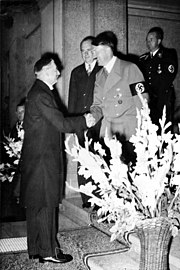A false dilemma is seen whenever only two possible options are given when there exist others. (This fallacy is also known as a false dichotomy). For example, a person might insist, “you’re either with me or against me” and hence force the listener to join forces or else be taken as an enemy. In general, we have the following:
P1: Either A or B;
P2: Not A;
C: Therefore, B.
The argument seems valid but a premise is missing; namely, something like “P3: No other options other than A and B exist.” It is often used for rhetorical effect; after all, if only two choices are available and one is unpalatable then we are forced to choose the other, even if we might otherwise have reservations.
(Newall, 264)

Some historians have fallen into this fallacious reasoning when addressing Neville Chamberlain’s responses to Hitler. Essentially the argument has been:
P1: Chamberlain had the option to either [A] stand up to Hitler and prevent war or [B] appease him and lead to further demands and world war.
P2: Chamberlain did not [A] stand up to Hitler and prevent war.
C: Therefore, [B] Chamberlain is to be blamed for making the cowardly choices that led to war.
What is missing are other “dilemmas” facing Chamberlain:
or C: Chamberlain believed Russia was a serious threat and believed Hitler would invade east, not west.
or D: Chamberlain feared Japan and Italy would take advantage of Britain being tied down with Germany to overrun British interests in Asia and the Mediterranean.
or E: Chamberlain knew Britain would not tolerate another war given their fresh memories of the horrors of the last one.
As summed up by Paul Newall: Continue reading “Logical Fallacies of Historians: the False Dilemma (Dichotomy)”
